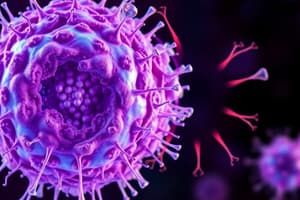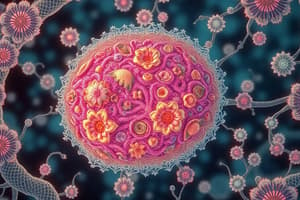Podcast
Questions and Answers
What is the primary advantage of being multicellular in terms of body size?
What is the primary advantage of being multicellular in terms of body size?
- Cells can become more specialized
- Organisms can exceed body limits caused by the SA:Vol ratio (correct)
- Cells can grow larger in size
- Organisms can reproduce more quickly
What is the main difference between pluripotent and totipotent stem cells?
What is the main difference between pluripotent and totipotent stem cells?
- Pluripotent stem cells are found in adults, while totipotent stem cells are found in embryos
- Totipotent stem cells can form any cell type and divide into new organisms, while pluripotent stem cells can only form any cell type (correct)
- Totipotent stem cells are found in adults, while pluripotent stem cells are found in embryos
- Pluripotent stem cells can form any cell type and divide into new organisms, while totipotent stem cells can only form any cell type
What is the result of cell specialization in multicellular organisms?
What is the result of cell specialization in multicellular organisms?
- Each cell performs a large number of functions inefficiently
- Cells become less dependent on each other
- Each cell performs a small number of functions extremely efficiently (correct)
- Cells become more susceptible to disease
What is the characteristic of stem cells that allows them to continuously divide?
What is the characteristic of stem cells that allows them to continuously divide?
What is the primary reason for the limited availability of stem cells?
What is the primary reason for the limited availability of stem cells?
What is the process by which a stem cell becomes specialized?
What is the process by which a stem cell becomes specialized?
What is the primary advantage of eukaryotic cells having discrete organelles?
What is the primary advantage of eukaryotic cells having discrete organelles?
What is the significance of compartmentalization in eukaryotic cells?
What is the significance of compartmentalization in eukaryotic cells?
How does the SA:Volume Ratio affect the metabolic rate of a cell?
How does the SA:Volume Ratio affect the metabolic rate of a cell?
What is the role of alliinase in garlic cells?
What is the role of alliinase in garlic cells?
Why do cells vary in size, shape, and organization?
Why do cells vary in size, shape, and organization?
What happens to the SA:Volume Ratio as a cell grows larger?
What happens to the SA:Volume Ratio as a cell grows larger?
Why is it beneficial for cells to be small?
Why is it beneficial for cells to be small?
What is the consequence of a cell's metabolic rate exceeding its ability to obtain materials?
What is the consequence of a cell's metabolic rate exceeding its ability to obtain materials?
Study Notes
Eukaryotic Cells
- Eukaryotic cells are more efficient than prokaryotic cells due to their discrete organelles, which are specialized to carry out specific tasks.
- Eukaryotic cells are compartmentalized, allowing for separation of tasks and protection of sensitive components.
Advantages of Compartmentalization
- Separation of the nucleus and cytoplasm keeps DNA safe.
- Enzymes and substrate can be more concentrated in a small area, increasing efficiency.
- Harmful chemicals can be isolated, and pH levels can be maintained at different levels for different metabolic reactions.
- Organelles can be moved, and larger membrane surface areas can be used for processes that take place across a membrane.
- Example: Garlic cells contain alliin in vacuoles, which is converted to allicin (a toxic compound) when mixed with the enzyme alliinase, providing protection against herbivores.
Cell Specialization
- All living things are made up of cells, but individual cells in different tissues can be quite different from one another.
- The function of a cell determines its structure, and cells vary in size, shape, and organization.
SA:Volume Ratio
- Cell size is limited by energy and material requirements needed to stay alive.
- Volume determines energy consumption, while surface area determines the rate of exchange with surroundings.
- As a cell grows larger, its volume increases faster than its surface area, leading to a decrease in the SA:Volume Ratio.
- If the metabolic rate exceeds the cell's ability to obtain material, the cell will die, making it beneficial for cells to be small.
Being Multicellular
- Multicellular organisms are formed by repeated cell division and the grouping of similar cell types.
- Being multicellular allows organisms to exceed body limits caused by the SA:Vol ratio, enabling growth without increasing cell size.
- Cell specialization allows cells to become efficient in specific functions, interacting to achieve complex functions.
Differentiation
- Every cell in a multicellular organism is a clone of an original parent cell (except gametes), with identical DNA.
- Certain cells express specific genes, while others express other genes, leading to differentiation.
Stem Cells
- Stem cells are unspecialized cells with self-renewal and potency properties.
- When a stem cell differentiates and becomes specialized, it cannot change again.
- Stem cells are limited in availability.
Types of Stem Cells
- There are three types of stem cells found at different stages of development:
- Totipotent: can form any cell type and divide into new organisms.
- Pluripotent: can form any cell type.
- Multipotent: can form a number of closely related cell types.
Studying That Suits You
Use AI to generate personalized quizzes and flashcards to suit your learning preferences.
Description
Understand the advantages of compartmentalization in eukaryotic cells, including the separation of the nucleus and cytoplasm, and the specialization of organelles for specific tasks.




